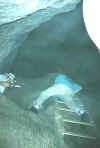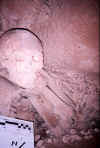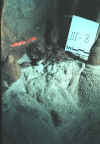 This
chamber remained undiscovered until recently because it is so hard to reach,
many meters above the floor of the cave.
This
chamber remained undiscovered until recently because it is so hard to reach,
many meters above the floor of the cave.Welcome to the Cave of the Glowing
Skulls
In memory of Dr. George Hasemann
 This
chamber remained undiscovered until recently because it is so hard to reach,
many meters above the floor of the cave.
This
chamber remained undiscovered until recently because it is so hard to reach,
many meters above the floor of the cave.
Limestone is composed of the mineral calcite (CaCO3). Rain water dissolves carbon dioxide as it falls, forming carbonic acid (H2O + CO2 = H2CO3). This acidic water dissolves small quantities of calcite, enlarging fractures through which the rain water flows. Over geological spans of time, enormous voids can develop. As these voids reach the surface and air begins to circulate through the cave, evaporating water leaves behind the calcite once held in solution and depositional features develop.
 Stalactites
and stalagmites - and perhaps the largest rimstone structures documented -
decorate the upper burial chamber.. Note that calcite crystals (white)
define the high-water mark, the level of the stone that held the water in this
natural tub. Rimstone structures grow as water slowly flows over the top
and down the other side, depositing additional calcite a molecule at a
time. These structures are thicker at their base than at their tops.
Stalactites
and stalagmites - and perhaps the largest rimstone structures documented -
decorate the upper burial chamber.. Note that calcite crystals (white)
define the high-water mark, the level of the stone that held the water in this
natural tub. Rimstone structures grow as water slowly flows over the top
and down the other side, depositing additional calcite a molecule at a
time. These structures are thicker at their base than at their tops.
 Dr. George Hasemann, archaeologist of the Instituto Hondureño de
Antropología e Historia, examines a burial preserved by its calcite coat.
Note the stocking feet. Great care must be taken not to track dirt into
the burial area. Just the oil from human fingers can stain and ruin
'living' flowstone - calcite formations still developing and growing as water oozes
from cracks in the cave ceiling.
Dr. George Hasemann, archaeologist of the Instituto Hondureño de
Antropología e Historia, examines a burial preserved by its calcite coat.
Note the stocking feet. Great care must be taken not to track dirt into
the burial area. Just the oil from human fingers can stain and ruin
'living' flowstone - calcite formations still developing and growing as water oozes
from cracks in the cave ceiling.
 Typical
burials consist of a stack of long bones with a skull placed on top. Gifts
were sometimes left inside this structure. Bits of charcoal from torches
provide scientists with C-14 for radiometric dating, while even the bones
provide clues to customs
and the diet of this ancient society.
Typical
burials consist of a stack of long bones with a skull placed on top. Gifts
were sometimes left inside this structure. Bits of charcoal from torches
provide scientists with C-14 for radiometric dating, while even the bones
provide clues to customs
and the diet of this ancient society.
 No
one knows how the flesh was stripped from bones before final burial.
Similar burial customs are found among ancient peoples throughout Central
America.
No
one knows how the flesh was stripped from bones before final burial.
Similar burial customs are found among ancient peoples throughout Central
America.
 Bones
coated with calcite have been preserved, while those exposed to oxygen have
largely decomposed, leaving few fragments.
Bones
coated with calcite have been preserved, while those exposed to oxygen have
largely decomposed, leaving few fragments.
 An
archaeologists works patiently, examining and sorting fragments from one of
these decomposed burials. Most of the calcite-covered remains were left
intact for future scientific investigations, but some have been damaged by grave
robbers. There has been NO precious material found in Talgua Cave,
which pre-dates widespread use of jade or gold in Mesoamerica.
An
archaeologists works patiently, examining and sorting fragments from one of
these decomposed burials. Most of the calcite-covered remains were left
intact for future scientific investigations, but some have been damaged by grave
robbers. There has been NO precious material found in Talgua Cave,
which pre-dates widespread use of jade or gold in Mesoamerica.